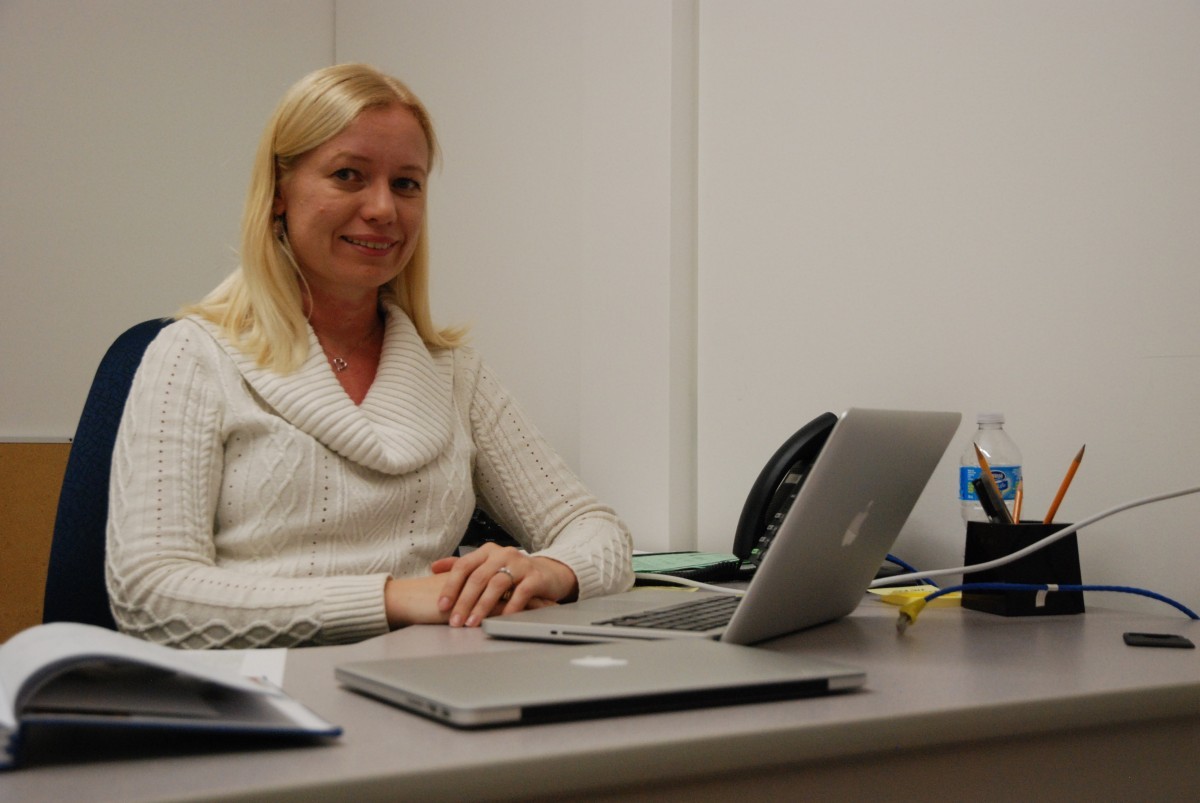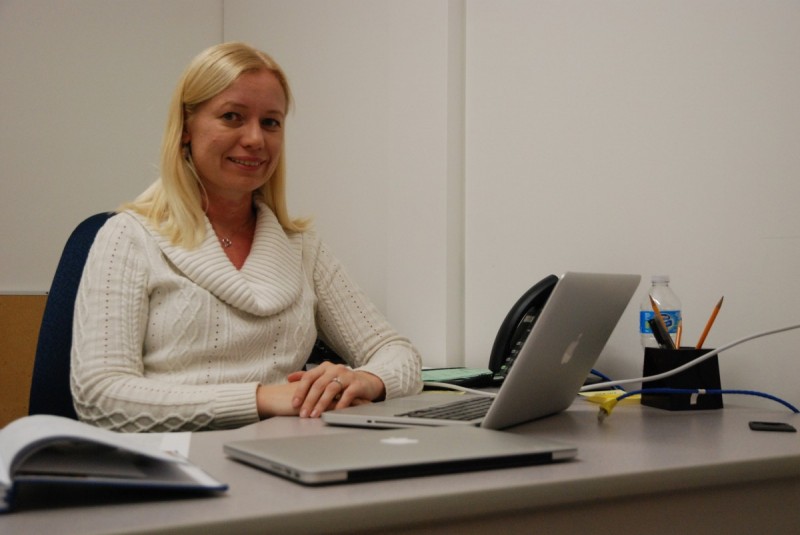
Merli Tamtik is currently teaching an undergrad course on issues related to teaching in Manitoba and in Canada.
New education professor focused on innovation and policy making research
'I feel very lucky to have been chosen' by U of M
Professor Merli Tamtik, whose research expertise is in university policy making and how governments can best support innovation and research production in education, has recently joined the Faculty of Education in the Educational Administration, Foundations & Psychology (EAF&P) department.
Tamtik just moved to Manitoba on Jan. 3, 2016 (brr!) from Toronto’s York University, where she was completing her post-doctoral research on how governments can best support innovation and research production in education. Her PhD thesis, entitled “Expertise and Policy Learning – The Case of EU’s Research Policy”, examined policy learning initiatives as a coordination method in the European Union context.
She recently sat down for a Q&A about her new role in EAF&P, her research, teaching aspirations and her new home of Winnipeg.
Q. Can you talk a bit about your research?
A. My research projects have mainly focused on the issues of policy, governance and post-secondary education. I have done some work on the internationalization of higher education as well but most importantly I’ve been focused on research and innovation policy and its coordination. Research production and knowledge mobilization is the core of what universities are all about.
I’m looking at how research policy gets developed and how governments can best support knowledge production in universities.
In my doctoral thesis I looked at how the policy making process takes place in the European Union context. Here in Canada, we tend to talk about the messiness of policy making between the federal government and the provincial government but in the European Union they have to deal with 28 different member states and 28 different research systems trying to build some sort of coherence across those systems. So what the EU has done, they have applied a unique model to coordinate these systems called the Open Method of Coordination. In my thesis I examined how this method works and is this something that we can apply in Canada.
The OMC method applies policy learning as a tool to coordinate policies. And what that means is they are trying to get together experts and government specialists that work on research policy to learn from each other and share their best practices. The EU does not have direct legal powers over education in the member states so they are trying to use “soft coordination models” to get to this point where policies are coordinated. So policy learning is used.
My thesis looked at how these individual policy learning experiences contribute to coordinated research policy in the EU. The findings suggest that individual policy learning experiences do make a difference and they shape the development of EU research policy.
Q. How does it help?
A. It does not lead to very quick, instrumental outcomes to change the policy. But it helps in terms of updating policy beliefs of participants. It helps to create mutual ownership of decisions as there has been a lot of resistance among the EU member-states in terms of following what the European Commission at the supranational level [does] but these kinds of soft methods help—the experts they learn that there are other ways to do it, there are ways to learn from each other, from each others failures and that gradually leads to harmonized systems. That’s the basis of my thesis.
Q. What other projects were you involved in?
A. I did a post-doc at York University’s Faculty of Education. I continued with the theme of policy coordination, moving from the EU to Canada. In my postdoctoral research project I’m looking at how innovation policy gets coordinated. I use the case of Ontario to find out what kind and how much of policy coordination is needed. I conducted interviews with 40 stakeholders. I’m still in the process of analyzing my data so it’s not a finished project yet and I’m still working on it.
Q. And what will you be teaching here?
A. This term I’m teaching one course for two groups of B.Ed. students–Canadian School Systems and their Public Purposes. So in the new academic year I’m hoping to teach a course that builds on my own experiences in higher education and policy making.
Q. With the course you are teaching, what are you exploring with students?
A. We are talking about the Manitoba public education school system, how that has developed, what are some of the legal aspects and how to translate those into practice. It’s a foundational, introductory course on what are the issues related to teaching in Manitoba and in Canada in general. After this course the students are going to their practicums so they need the basic understanding of how the school system operates.
In the next academic year I will continue with this course and I’m hoping to teach a course in higher education and policy making. It will probably be at the graduate level but we haven’t settled that yet.
Q. Why did you want to join U of M?
A. The academic job market is very very competitive so I feel very lucky to have been chosen by Manitoba. I think there was a great match between my background and what the Faculty of Education was looking for. They are interested in building the capacity in the area of post-secondary education, and this is where I come in as an early career researcher and an academic. This would be a fantastic opportunity to contribute my expertise and skills to the area that is being strengthened.
I was really pleased to learn that to the Faculty of Education research is important. There are many funding opportunities both in the department as well as in the university. We have a research facilitator, Karen [Schwartz] who sends out a wonderful newsletter that is absolutely key for professors like me. So the supportive environment for research is a huge advantage here.
Finally, I think the working atmosphere is very collegiate. People just come by, drop by and say hi asking me if I need anything. I have had a lot of very productive conversations with faculty members and staff. That kind of environment makes it very easy to settle and move forward.
Q. Which research projects will you be working on/toward?
A. Finishing my post-doc project first. In the spring, I’m hoping to start a new project that takes this innovation theme to a different place. I’m trying to understand and connect how innovation is understood by Aboriginal faculty members and how they have been able to legitimize their values and norms so that it is seen as a strength in current academic culture in Canada.
Q. What do you hope to achieve here?
A. As a starting faculty member you are expected to do teaching, research and service. I really love teaching. I absolutely enjoy it as you learn so much from your students. I hope to build long-lasting and productive relationships with my students and am hoping to strengthen the field of higher education in the faculty. I’m also hoping to build my portfolio through meaningful research that actually matters, and can contribute to the people and community here in Manitoba.
Q. Can you tell us a bit about your background?
A. I grew up in Estonia. The winters are as cold as here. Well maybe not that cold, but… moving here to Winnipeg it kind of reminds me of my childhood in Estonia. Big piles of snow, -20 degrees. The sky is always blue. This change hasn’t been as dramatic or shocking to me as some might expect. I completed my undergraduate degree at University of Tartu in Estonia and got my Masters in Special Needs Education there but my first job was in university administration, not in special needs.
I started working as a student advisor to those students who wanted to study abroad in U.S. or Canada. And then the Bologna Process happened. It was a shift that changed all the educational systems in the EU. So we used to have a four year undergraduate degree, and a two-year masters degree, and that changed to a three-year bachelor to a one-or-two-year masters. As an administrator I was in the middle of this major shift and it influenced the lives of not only students but faculty members and administrators and the whole university. I kind of got interested in understanding how can this be, that the policy decision of a few people can make such a huge change to so many people?
There wasn’t a program in Estonia in higher education policy but there was a program in higher education theory and policy with the collaborative focus on international and comparative education offered by the Ontario Institute for Studies in Education at the University of Toronto so I thought I would apply. I moved to Canada in 2007. I did my MA degree first, then I got accepted to the PhD program and finally got an SSRHC grant for postdoctoral research. I was very lucky to work with exceptional scholars such as professor Creso Sa, professor Ruth Hayhoe and professor Theresa Shanahan. It was largely thanks to them who motivated me to follow their example and pursue my dream of becoming a university professor.
Q. When did you graduate?
A. I convocated from my Masters degree on Nov. 11, 2009, defended my PhD degree on Nov. 11, 2013 and on Nov. 11, 2015 I signed my contract with the U of M!
Q. Wow, that sounds like your lucky day?!
A. Yes, it is!







